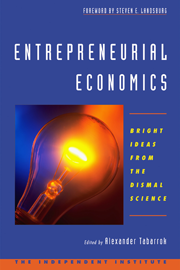Forget the talk of recession. The world is about to enter a new era in which miracle drugs will conquer cancer and other killer diseases and technological and scientific advances will trigger unprecedented economic growth and global prosperity.
Pie in the sky optimism? Perhaps. But there are reasons to be optimistic, and they rest not on science fiction but within the badly misnamed “dismal science,” economics.
To understand why economics triggers such optimism, imagine that there are two deadly diseases. One disease is relatively rare, the other common. If you had to choose, would you rather be afflicted with the rare or the common disease?
If you don’t want to die, it’s much better to have the common disease. The reason? The cost of developing drugs for rare and common diseases are about the same, but the revenues aren’t. Pharmaceutical companies concentrate on drugs with larger markets because larger markets mean more profits.
As a result, there are more drugs to treat diseases with a lot of patients than to treat rare diseases, and more drugs means greater life expectancy. Patients diagnosed with rare diseases—those ranked at the bottom quarter in terms of how frequently they are diagnosed—are 45% more likely to die before age 55 than are patients diagnosed with more common diseases.
So imagine this: If China and India were as wealthy as the U.S., the market for cancer drugs would be eight times larger than it is today.
Of course, China and India are not yet as wealthy as the U.S., but their economies are growing rapidly, and with them, the market for new drugs. Cancer is now China’s leading killer, with spending on treatment increasing by 17% per year. To be close to the Chinese market, AstraZeneca and Novartis are building major research facilities in China, which will benefit patients everywhere.
Like pharmaceuticals, new computer chips, software and chemicals also require large research and development (R&D) expenditures. As India, China and other countries become wealthier, companies will increase their worldwide R&D investments. Most importantly, as markets expand, companies and countries will put to work the greatest asset of all for the betterment of mankind: brain power.
Amazingly, there are only about 6 million scientists and engineers in the entire world, nearly a quarter of whom are in the U.S. Poverty means that millions of potentially world-class scientists today spend their lives trying to eke out a subsistence living, rather than leading mankind’s charge into the future. But if the world as a whole were as wealthy as the U.S. and were devoting the same share of population to research and development, there would be more than five times as many scientists and engineers worldwide.
People used to think that more population was bad for growth. In this view, people are stomachs—they eat, leaving less for everyone else. But once we realize the importance of ideas in the economy, people become brains—they innovate, creating more for everyone else.
New ideas mean more growth, and even small changes in economic growth rates produce large economic and social benefits. At current income levels, with an inflation-adjusted growth rate of 3% per year, America’s real per capita gross domestic product would exceed $1 million per year in just over 100 years, more than 22 times higher than it is today. Growth like that could solve many problems.
In the 20th century, two world wars diverted the energy of two generations from production to destruction. When the horrors ended, the world was left hobbled and split. Communism isolated much of the world, reducing trade in goods and ideas—to everyone’s detriment. World poverty meant that the U.S. and a few other countries shouldered the burdens of advancing knowledge nearly alone.
The battles of the 20th century were not fought in vain. Trade, development and the free flow of people and ideas are uniting all of humanity, maximizing the incentives and the means to produce new ideas. This gives us reason to be highly optimistic about the future.












